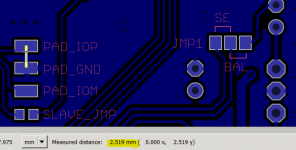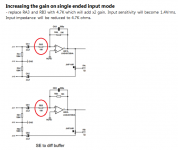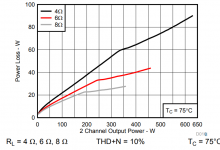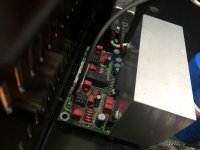Sometimes the Silmic IIs dampen down the airiness at the upper end while "warming" the signal. People sometimes says they provide a "tube-like" sound but I don’t own a tube amp so I can’t vouch for that. The bi-polar MUSEs do create a bit of a aggressive upper end while neutralizing any emphasis in mods and lows (not bad if your speaker system needs that). One should also consider the "plain Jane” Nichicon KA series in the signal path. I like them for their airiness. All of them take a bit of playing to break them in.
My guess is that the op-amp picked as "your best sounding" will be affected by the choice of signal path caps as well as the overall amp design. For instance I bought a newer version of the 3e-Audio amp which came with "silmic II" caps (supposedly; one of the three cap versions that were sent out). The color of those Elna caps made them look like Cerafines than Silmic IIs. But the amp sounded really good. I changed the 8 caps out with Silmic IIs from Mouser and the sound completely changed (muted the upper end a bit ) and didn’t get any better after a week or two of playing. I changed out the 4 caps post-op amps with the KA caps which instantly improved the sound which only got better over time. Obviously Op-amp choice will still play a role in what one hears.
Cheers, Pete
Good analyse turion64, I don't know the sound of Nichicon KA but it's possible to match better with TPA... and your right the bundle OPAMP and input cap is primordial.
Another reference from Nichicon is in stock on Mouser:
Nichicon UKW Serie 50 VDC Condensateurs electrolytiques en aluminium - Fils radiaux – Mouser France
I read good review for this UKW... maybe better than KA/UKA ? (KA series start at 22µF, it's was too mutch for input cap for me)
Nichicon UKW Serie 50 VDC Condensateurs electrolytiques en aluminium - Fils radiaux – Mouser France
I read good review for this UKW... maybe better than KA/UKA ? (KA series start at 22µF, it's was too mutch for input cap for me)
Last edited:
AlexScan, you are correct about the KAs not going down to 10uF. I used 10uF KTs which actually look the same as KAs (light blue with “Audio” printed on the side). I use KAs for anything bigger than 10uF. Some of the more upper end series (MUSE KZs?) have the issue that their diameters are always slightly bigger and sometimes don’t fit as drop-in replacements.
My bad,
Pete
My bad,
Pete
Hi JLesterP, a few questions for you on the TICore260BTL (looks really nice by the way):I updated my recommended opamps in my online shop from LM4562 to LME49720NA (in budget category). LME49860 for high end sound.
After swapping opamps here and then, LME49720NA is smoother overall for me compared to LM4562. It has more coherence specially on different types of music.
TICore260BTL Stereo TPA3255 PFFB Post Filter Feedback Class-D Module | jlelectronicsph
1) Are there terminals for multi-board synchronization to avoid beat interference?
2) What is the integrated noise output of each channel? With PFFB on, and with PFFB off, if possible?
3) Is there a startup manual? I'm not sure if I am missing something on the product page, but I'm not sure exactly what has to be added where, and depending on what option is purchased.
4) Do you have IMD measurements, e.g. 60 Hz + 7 kHz @ 4:1, 18 kHz + 19 kHz @ 1:1, 1 kHz + 5.5 kHz @ 1:1, etc.?
5) Do you have measurements of THD+N vs power output?
6) Do you have measurements of THD+N at higher frequencies, 5 kHz or 10 kHz?
Looking for up to two boards to use alongside my two existing TPA3255EVM to build an 8-channel amp. Was planning on 4 channels being LM3886-based, but if the performance is good enough with these, it would save me the trouble of a whole bunch of soldering and accommodating a different power supply (already have an SMPS800RS).
D
Deleted member 148505
My criteria for selecting suitable opamp is for openness and transparency in sound. For LM4562 it's like recoding sound with noise cancellation in the microphone turned-on, some background details are muted. For LME49860 it's like recording without software correction. I can hear more ambient sound from it.
Sometimes the Silmic IIs dampen down the airiness at the upper end while "warming" the signal. People sometimes says they provide a "tube-like" sound but I don’t own a tube amp so I can’t vouch for that. The bi-polar MUSEs do create a bit of a aggressive upper end while neutralizing any emphasis in mods and lows (not bad if your speaker system needs that). One should also consider the "plain Jane” Nichicon KA series in the signal path. I like them for their airiness. All of them take a bit of playing to break them in.
My guess is that the op-amp picked as "your best sounding" will be affected by the choice of signal path caps as well as the overall amp design. For instance I bought a newer version of the 3e-Audio amp which came with "silmic II" caps (supposedly; one of the three cap versions that were sent out). The color of those Elna caps made them look like Cerafines than Silmic IIs. But the amp sounded really good. I changed the 8 caps out with Silmic IIs from Mouser and the sound completely changed (muted the upper end a bit ) and didn’t get any better after a week or two of playing. I changed out the 4 caps post-op amps with the KA caps which instantly improved the sound which only got better over time. Obviously Op-amp choice will still play a role in what one hears.
Cheers, Pete
D
Deleted member 148505
For 1) There are solder pads under the PCB for osc_iop and osc_iom as well as DVDD jumper on freq_adj pin.
For 2, 4, and 6) I only measured THD+N on 1W, 5W, and 10W at 8 ohms load. As well as output integrated noise (inputs shorted without A-Weighting). Also tried 6.67kHz at 20W (20khz bandwidth) just to verify if it is really within spec, result is just a small blip on second harmonic. I got < 0.003% THD+N, but wasn't able to capture screenshot.
I am not sure if I'm getting optimal results with my QA400, so I'm planning to send it to audiosciencereview. Currently preparing for it by creating PCB for low noise preamp supply (using tps7a3001/tps7a4901). I am also looking for a nice aluminum chassis and 600W SMPS with > 100kHz switching freq. Then still deciding if I will send it with balanced or single ended inputs.
For 5) This is easy, I can do it next weekend.
For 3) Startup manual is still a work in progress. For multi device configuration you can refer to SLAA787 app note.
For 2, 4, and 6) I only measured THD+N on 1W, 5W, and 10W at 8 ohms load. As well as output integrated noise (inputs shorted without A-Weighting). Also tried 6.67kHz at 20W (20khz bandwidth) just to verify if it is really within spec, result is just a small blip on second harmonic. I got < 0.003% THD+N, but wasn't able to capture screenshot.
I am not sure if I'm getting optimal results with my QA400, so I'm planning to send it to audiosciencereview. Currently preparing for it by creating PCB for low noise preamp supply (using tps7a3001/tps7a4901). I am also looking for a nice aluminum chassis and 600W SMPS with > 100kHz switching freq. Then still deciding if I will send it with balanced or single ended inputs.
For 5) This is easy, I can do it next weekend.
For 3) Startup manual is still a work in progress. For multi device configuration you can refer to SLAA787 app note.
Hi JLesterP, a few questions for you on the TICore260BTL (looks really nice by the way):
1) Are there terminals for multi-board synchronization to avoid beat interference?
2) What is the integrated noise output of each channel? With PFFB on, and with PFFB off, if possible?
3) Is there a startup manual? I'm not sure if I am missing something on the product page, but I'm not sure exactly what has to be added where, and depending on what option is purchased.
4) Do you have IMD measurements, e.g. 60 Hz + 7 kHz @ 4:1, 18 kHz + 19 kHz @ 1:1, 1 kHz + 5.5 kHz @ 1:1, etc.?
5) Do you have measurements of THD+N vs power output?
6) Do you have measurements of THD+N at higher frequencies, 5 kHz or 10 kHz?
Looking for up to two boards to use alongside my two existing TPA3255EVM to build an 8-channel amp. Was planning on 4 channels being LM3886-based, but if the performance is good enough with these, it would save me the trouble of a whole bunch of soldering and accommodating a different power supply (already have an SMPS800RS).
Last edited by a moderator:
Good cap on smps600rs commstech, can you tell us the model and value of Epcos and Wurth ?
Sure. Here they are:
861140783006 Wurth Elektronik | Mouser Singapore
https://www.mouser.sg/ProductDetail...%2brM%2bQkQ==&countrycode=SG¤cycode=SGD
The Epcos replaced the Teapo and the Wurth replaced the Samwha. I have checked their specs for max. permissible ripple current to match what Connex has on the board. I maintained the same capacitance value , just in case larger values may create a start up problem.
Thanks, do you have a PCB drawing and/or pad sizes for these?For 1) There are solder pads under the PCB for osc_iop and osc_iom as well as DVDD jumper on freq_adj pin.
What is the integrated noise? I didn't see the spec on the product page.For 2, 4, and 6) I only measured THD+N on 1W, 5W, and 10W at 8 ohms load. As well as output integrated noise (inputs shorted without A-Weighting). Also tried 6.67kHz at 20W (20khz bandwidth) just to verify if it is really within spec, result is just a small blip on second harmonic. I got < 0.003% THD+N, but wasn't able to capture screenshot.
Really looking forward to ASR measurements. Does this interest you at all? Linear Audio Silent Switcher V3 – diyAudio StoreI am not sure if I'm getting optimal results with my QA400, so I'm planning to send it to audiosciencereview. Currently preparing for it by creating PCB for low noise preamp supply (using tps7a3001/tps7a4901). I am also looking for a nice aluminum chassis and 600W SMPS with > 100kHz switching freq. Then still deciding if I will send it with balanced or single ended inputs.
Amir can test either balanced or single-ended.
Oh! Another question: is there a way to increase the onboard gain by easily swapping resistors? For the people who have sources between 1.5 V to 2 V max output.
Last edited:
D
Deleted member 148505
Thanks, do you have a PCB drawing and/or pad sizes for these?
What is the integrated noise? I didn't see the spec on the product page.
Attached PCB drawing of IOM/IOP pads. Pitch is around 2.5mm
Attached integrated noise, the speaker out is connected to a sound card interface with -6dB gain so probably it's around 44uVrms. I will setup a new test for this to confirm.
Yes already aware of the silent switcher. I need isolated 5V to +/-12V because I will also use it on my sound card interface.Really looking forward to ASR measurements. Does this interest you at all? Linear Audio Silent Switcher V3 – diyAudio Store.
For single ended, yes. The input section is the same as EVM. (attached screenshot)Oh! Another question: is there a way to increase the onboard gain by easily swapping resistors? For the people who have sources between 1.5 V to 2 V max output.
Attachments
Last edited by a moderator:
D
Deleted member 148505
Hello Lester , did u measure the temp of the TPA3255 heat sink at full power ?
Thanks
Haven't measured it, but with ATS-TI1OP-519-C1-R3, it cannot sustain full power for several seconds because its thermal resistance is only 2.2 C/W. Heat dissipation of TPA3255 IC is around ~20W at 100W output power (see attached pic)
With 28 deg C ambient temp and normal room airflow, I can only run 80W at 4 ohms continuous sine wave without triggering OTP. Or 40W/ch continuous both left and right channels driven. With 300W at 4 ohms it will only last for seconds before triggering OTP.
At near clipping loudness, it will depend on what music content is being played if the TPA3255 will trigger OTP. If you're listening to CD-quality music which has a high dynamic range, then you're good. If you are playing highly compressed material with more than 1/3 the energy of sine wave then it will trigger OTP for sure.
It is a non issue really unless you will use the module on outdoor / PA which requires music material's dynamic range to be compressed.
If you want detailed maths for thermal considerations, Neurochrome / tomchr has a good and straightforward article regarding the subject.
Taming the LM3886 Chip Amplifier: Thermal Design – Neurochrome
Also Rod Elliot
Heatsinks And Amplifiers
Regards,
Lester
Attachments
Last edited by a moderator:
D
Deleted member 148505
So are there other heatsink options ?
You need a custom L-bracket for it, or a fan.
The TPA3255 IC is really small for what it is supposed to do. If you want to maximize its output, I would recommend going with a direct-contact heat pipe heatsink, e.g. Cooler Master Hyper 212 Evo with a custom mounting bracket.So are there other heatsink options ?
Hyper 212 EVO | Cooler Master
Second best, and way simpler, is just to put a very quiet fan to drastically improve the ATS heatsink's thermal resistance. Lots of near-silent and truly-silent 120 mm and 140 mm options from companies such as Noctua.
Last edited:
Why? Once the heat output "fills up" the thermal inertia of the block, it just becomes an extremely inefficient heatsink.A big aluminum block would work?
This is p3a amplifier beautifully built by one of the members of this forum and it uses a large aluminum block .
D
Deleted member 148505
D
Deleted member 148505
Amir can test either balanced or single-ended.
I think I will just create a power amp with balanced input. I will change the resistors to 6.8K ohm (0.05% 0603 SMT) so that 2Vrms signals can drive the amp into full power.
Since Amir is running the amp with both channels into full power for several minutes, TPA3255 with 48~51V cannot handle the heat dissipation using just the EVM heatsink. So our main concern here is the continuous full power dissipation. (Maybe that's why there are no TPA3255 reviews yet in ASR) I'm also doubting the AP measurements of 3eaudio TPA3255, their graphs look like they measured the amp with PFFB, plots are strikingly similar.
I will reduce the power supply to 36V so that the power loss will be lower. Then configure the PFFB to 36V TPA3251.
With 36V supply, based on TPA3251 system power loss graph, the chip will only dissipate 24W at 200W 4 ohms output.
So the chip can sustain output of 100W/ch or a total of 200W @ 4 ohms indefinitely (25 deg C ambient) with ATS-TI1OP-519-C1-R3 and some air cooling.
Final specs of 'sample' amp for audio performance measurement with FTC rule requirement.
Main Amp Module: TICore260BTL PFFB configured to 36V TPA3251, Bal input.
Power Supply: RPS-400-36 (only 79USD on mouser)
Automatic fan cooling using thermostat.
Continuous output power: 100W/ch into 4 ohms
Peak output power (10% THD): 175W/ch into 4 ohms.
Attachments
- Status
- Not open for further replies.
- Home
- Vendor's Bazaar
- Amplifier Modules and PCBs For Sale





